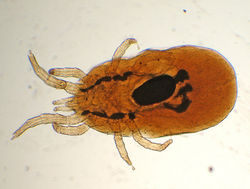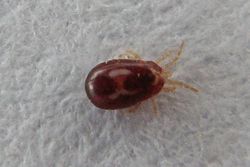Dermanyssus gallinae
|
| Dermanyssus gallinae | |
|---|---|
| Phylum | Arthropoda |
| Order | Mesostigmata |
| Family | Dermanyssidae |
| Genus | Dermanyssus |
| Species | D.gallinae |
Also Known As: Poultry Mite — Red Poultry Mite — Poultry Red Mite — Chicken Mite
Introduction
Dermanyssus gallinae are ectoparasitic or surface mites of poultry and other bird species (both wild and domesticated).
D. gallinae are superficially similar to spider mites. They are generally white or greyish in colour, becoming darker or redder when engorged with blood after feeding. They have few hairs on their body and have hooks on their long legs.
D. gallinae are considered one of the most serious pests of poultry[1]. Mites affect hens both directly and indirectly, where they may serve as vectors for diseases such as Salmonellosis and avian spirochaetosis[2] . D. gallinae may also feed from livestock although the relationship between D. gallinae and mammalian hosts is stll poorly understood.
D. gallinae may also feed upon humans, causing dermatitis and skin lesions in people.[3]
Distribution
Japan, Australia, Brazil, and most of Northern Hemisphere including Europe and the USA.
Signalment
Though poultry (specifically laying eggs) are the primary host of D. gallinae, a range of domestic and wild birds can be infested[4]. The mites can also affect mammals and people[3], particularly where cohabitation with bird species occurs. Infestations of this nature are usually transient, presenting only when preferred avian hosts become unavailable (e.g. when young birds vacate nests in loft spaces).
Chicks and young birds are more susceptible.
Life Cycle
D. gallinae progresses through 5 life stages: egg, larva, protonymph, deutonymph and adult[5]. All stages except larvae require a bloodmeal in order to progress to the next stage.[6]
Development may take less than a week under optimal conditions[7] . Adults spend most of their time away from the host and can survive several months without feeding.[8] Most bloodfeeding occurs at night, with mites seeking refuge in cracks and crevices during daylight hours.
Clinical Signs
Dermanyssus gallinae are blood sucking mites, causing lesions usually found on the breast and legs of hens. For their hosts, feeding can cause pain, irritation, restlessness and a decrease in egg production[1]. Pustules, scales, scabs, hyperpigmentation and feather loss may develop locally. If secondary infection occurs, lesions may also exhibit a foul odour.
If they are present in large numbers, D. gallinae can cause anaemia in hens with consequent pallor, weakness and lethargy. Pallor may be especially pronounced in the comb and wattle.
Newly hatched chicks can rapidly die if infested.
Diagnosis
Diagnosis in flocks of laying hens is usually based on a history of decreasing egg production, anaemia, mortalities in young or ill birds and/or direct observation of mites either on birds or in refugia present in their vicinity (e.g. nest boxes, perches, etc.).
Blood-spotting (reddish-black drops of squashed mites and/or mite faeces) of eggs may be used to diagnose D. gallinae infestation.
Finally, specially-designed traps made from corrugated cardboard traps can be used to monitor premises for D. gallinae.
Treatment
Treatment of mites depends primarily upon ectoparasiticides, applied directly to hens or poultry units, often between flock cycles. Many compounds are effective, but food hygiene regulations and withdrawal periods should be considered when selecting a treatment. It is advisable to alternate the compound used in order to minimise resistance, which is already emerging. It should be noted that Ivermectin does not work against D. gallinae.
Control
In addition to curative treatment with ectoparasiticides, several preventative measures are recommended to control D. gallinae infestations. These include use of Hazard Analysis - Biological Control[9][10] agents and improved premise design [11].
| Dermanyssus gallinae Learning Resources | |
|---|---|
To reach the Vetstream content, please select |
Canis, Felis, Lapis or Equis |
 Test your knowledge using flashcard type questions |
Dermanyssus gallinae Flashcards |
 Search for recent publications via CAB Abstract (CABI log in required) |
Dermanyssus gallinae publications |
References
- ↑ 1.0 1.1 Chauve, C., 1998. The poultry red mite Dermanyssus gallinae (De Geer, 1778): current situation and future prospects for control. Veterinary Parasitology 79: 239-245
- ↑ Valiente Moro, C., De Luna, C.J., Tod, A., Guy, J.H., Sparagano, O.A.E., Zenner, L., 2009a. The poultry red mite (Dermanyssus gallinae): a potential vector of pathogenic agents. In: Sparagano, O.A.E. (Ed.), Control of poultry mites (Dermanyssus). Exp. Appl. Acarol. 48, 93-104.
- ↑ 3.0 3.1 Cafiero, M.A., Camarda, A., Circella, E., Santagada, G., Schino, G., Lomuto, M., 2008. Pseudoscabies caused by Dermanyssus gallinae in Italian city dwellers: a new setting for an ld dermatitis. J Eur Acad Dermatl Venereol 22: 1382-1383.
- ↑ Moss, W. W (1978) The mite genus Dermanyssus: a survey, with description of Dermanyssus trochilinis, n. sp. and a revised key to the species (Acari: Mesostigmata: Dermanyssisdae). J Med Entomology 14:627-640
- ↑ Maurer, V., Baumgärtner, J (1992). Temperature influence on life table statistics of the chicken mite Dermanyssus gallinae (Acari: Dermanyssidae). Experimental & Applied Acarology, 15(1):27-40; 19.
- ↑ Collins, D. S., Cawthorne, R. J. G (1976) Mites in poultry houses. Agric Northern Ireland, 51:24-26
- ↑ Maurer, V. & Baumgärtner, J., 1992. Temperature influence on life table statistics of the chicken mite Dermanyssus gallinae (Acari: Dermanyssidae). Experimental and Applied Acarology 15: 27-40.
- ↑ Axtell, R.C., 1999. Poultry integrated pest management; status and future. Integrated Pest Management Reviews 4: 53-73.
- ↑ Mul, M.F. & Koenraadt, C.J.M., 2009. Preventing introduction and spread of Dermanyssus gallinae in poultry facilities using the HACCP method. Experimental and Applied Acarology 48: 167-181
- ↑ Lesna, I., Wolfs, P., Faraji, F., Roy, L., Komdeur, J & Sabelis, M.W., 2009. Candidate predators for biological control of the poultry red mite Dermanyssus gallinae. Experimental and Applied Acarology 48: 63-80.
- ↑ Mul, M., van Niekerk, T., Chirico, J., Maurer, V., Kilpinen, O., Sparagano, O., Thind, B., Zoons, J., Moore, D., Bell, B., Gjevre, A.-G., Chauve, C., 2009. Control methods for Dermanyssus gallinae in systems for laying hens: results of an international seminar. World’s Poultry Science Journal 65: 589-600.

|
This article was originally sourced from The Animal Health & Production Compendium (AHPC) published online by CABI during the OVAL Project. The datasheet was accessed on 21 June 2011. |
| This article has been expert reviewed by Dr. David George Date reviewed: 23/08/11 |
Error in widget FBRecommend: unable to write file /var/www/wikivet.net/extensions/Widgets/compiled_templates/wrt662301a685edb0_53143821 Error in widget google+: unable to write file /var/www/wikivet.net/extensions/Widgets/compiled_templates/wrt662301a6894b18_60557384 Error in widget TwitterTweet: unable to write file /var/www/wikivet.net/extensions/Widgets/compiled_templates/wrt662301a68c7509_20566747
|
| WikiVet® Introduction - Help WikiVet - Report a Problem |


